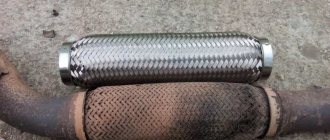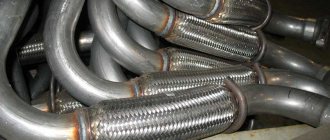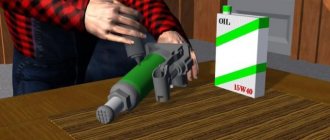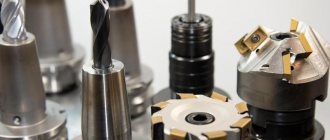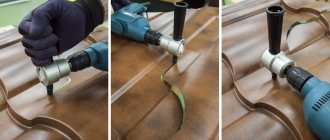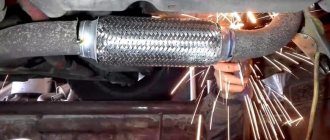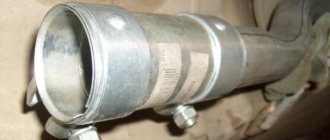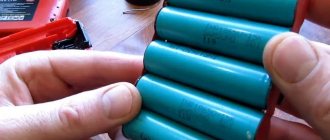When the exhaust system corrugation breaks, the sound of the engine changes dramatically. This is not critical, but such a malfunction can greatly spoil the driver’s nerves. If the problem is in the corrugation itself, then there is no point in restoring it, since the part is inexpensive and it is easier to simply replace it. Moreover, even a novice motorist can replace the muffler corrugation . Find out more about what an exhaust system bellows is and how to replace it yourself. Information about the corrugation and step-by-step instructions for replacing it are below in the article.
What it is
The corrugation, or, as it is also called, a vibration compensator, is a key element of a car exhaust system, installed on almost all modern models. The purpose of the corrugation is to protect the exhaust system from resulting vibration. Externally, the part looks like an elastic tube made of metal. The vibration compensator acts as an intermediary between the exhaust pipe of the muffler and the exhaust pipe.
What is a muffler corrugation
Note! The corrugation consists of a multilayer metal mesh, thanks to which the part is quite flexible.
Exhaust system corrugation
The disadvantage of the corrugation is its location. The fact is that the compensator is located at the bottom of the car, so when hitting any obstacle there is a high risk of damage to the part. In such cases, the element must be replaced.
Design and purpose of corrugation
Corrugation (from the French gaufrer - folds, patterns) or vibration compensator is a flexible element that acts as a flexible connection in the exhaust system. Outwardly, it looks like an elastic tube with metal weaving in the form of a multilayer mesh and is an intermediate link between the exhaust pipe and the exhaust pipe of the muffler. Corrugation is often used as a substitute for a section of a burnt-out exhaust pipe.
Due to its design, the corrugation not only compensates for the vibration that accompanies engine operation, but also dampens vibrations that occur when the car starts.
Corrugation is an elastic tube with metal weaving in the form of a multilayer mesh
The corrugation design can be very diverse. It can consist of two or three layers, and also have a single or double reinforced braid. In any case, the corrugation is made of durable stainless steel.
Despite its strength, the corrugation is quite sensitive to mechanical damage and is subject to wear.
Why do you need corrugation?
When the engine operates, vibration occurs in the exhaust system, which over time leads to the destruction of this system. The corrugation plays the role of a fuse , which absorbs all the vibrations that arise and prolongs the life of the car’s exhaust system. Therefore, it is the corrugation that fails first, replacing which will cost several times less than repairing the entire system.
Functions of the muffler corrugation
The elastic element of the exhaust system also allows the engine to move within a small range (in the longitudinal plane). Thanks to this, there is less pressure on other parts of the body, which is very important for the entire structure.
Why do you need a muffler corrugation?
Causes and signs of vibration compensator failure
Let's look at the most common reasons for failure of the exhaust system corrugation:
- presence of additives in fuel. Due to changes in the chemical composition of exhaust gases, corrosion forms on the metal of the corrugation;
- system elements (resonator, muffler or catalyst) are clogged. This leads to the appearance of excess pressure in the vibration compensator;
- mechanical damage to the part (driving on poor-quality road surface);
- exposure to external factors (chemicals from the road, water, snow or dirt).
Signs of a broken muffler corrugation
It is not difficult to identify a broken corrugation; you just need to pay attention to some signs. These include:
- the appearance of smoke or the smell of smoke from below the machine;
- the appearance of a sharp exhaust sound from under the bottom;
- a sharp knock when the engine is running;
- the exhaust pipe begins to dangle unnaturally;
- There is a smell of exhaust gases in the car interior.
The muffler corrugation has burned out.
If at least one of the listed signs appears, you should immediately seek help from specialists. If this is not possible, then you can inspect the corrugation and other elements of the exhaust system for damage.
Signs of corrugation failure
Since the corrugation is located under the car, it is difficult to see it without a lift or inspection hole.
The problem with it is most often diagnosed by sound - the engine starts to work too loudly when you press the gas pedal. Over time, the sound progresses: the “sporty” roar of the muffler turns into an annoying roar that gives you a headache, and all the neighbors know when you are returning home and send rays of goodness... Also, the burnt-out corrugation begins to let in exhaust gases, which can be felt in the cabin, and this is quite dangerous for people in the car, especially if you stand in a traffic jam for a long time. Therefore, change the corrugation at the first sign of a malfunction and monitor its condition every time the machine is serviced on a lift.
Is repair possible?
If the muffler corrugation is burnt out or out of order, then there is no point in repairing or restoring it; only replacement will help. Of course, there are folk “craftsmen” who manage to somehow repair corrugations. But such would-be craftsmen should be sent away, because the design features of the part do not allow this to be done efficiently.
Repair or replacement of muffler corrugation?
On a note! The average service life of a new corrugation is 2-3 years, but this depends on the quality of the installed part.
Choosing a muffler corrugation
Depending on the characteristics of their work, corrugations are divided into two types. You need to know these points in order to understand what type of vibration compensator is suitable for your car. Let's consider each type separately.
Types of exhaust system corrugations
Compression work
This corrugation is located vertically and when the motor operates it straightens and contracts. Such vibration compensators are considered reinforced, so when replacing it is important to select a part that is exactly the same size (diameter 65 mm, length no more than 150 mm).
Compression corrugation
Replacing the muffler corrugation
The replacement procedure can be divided into several stages. This is dismantling the old corrugation using a grinder, installing a new element and processing the welding seams. In order for the corrugation to last as long as possible, all actions must be performed correctly. Everything must start with the preparatory process.
Replacing the muffler corrugation
Preparation
To make the work easier, it is advisable to remove the entire pipe with corrugation, and then change this element. This will also give you the opportunity to inspect other parts of the exhaust system and replace them if necessary. To work, you need to prepare an angle grinder, a welding machine, a set of keys and a new corrugation. Only after you have everything you need at hand and the corrugated pipe has been removed, you can begin replacement.
Removing the exhaust pipe
Step-by-step instruction
The replacement process is simple if you understand this issue. Below are detailed instructions for replacing the vibration compensator, following which you will be able to complete the job without any problems or difficulties.
Step 1 . Remove the battery terminal. This must be done before starting any welding work on the car.
Removing the battery terminal
Step 2. Inspect the muffler corrugation.
Visual inspection of the muffler corrugation
Step 3. Remove the corrugated pipe. To do this, you need to unscrew the fasteners that are most likely stuck. In such cases, you need to use WD-40. Before removal, you need to disconnect the lambda probe.
Exhaust pipe removed
Step 4. Make marks on the pipe where you cut. Chalk or marker - it doesn't matter.
Markings on the exhaust pipe
Step 5. Cut out the old corrugation using a grinder.
Cutting out old corrugation
Step 6. Try to cut as evenly as possible, so that later it will be easier to join the metal and weld it.
Smooth and neat cut
Step 7. Clean the cut area, making it as even as possible.
Cleaning the cut area
Step 8. Place the corrugation at the joint and begin welding.
Welding corrugation with pipe
Step 9. The welding seam should be smooth and without gaps so that smoke does not leak out.
The seam should be smooth and without gaps
Step 10. One edge of the corrugation is welded and completely ready.
The corrugation is welded on one side
On a note! If you do not have experience in welding, you can ask a friend or acquaintance for this purpose.
Step 11. Cut the corrugation on another part of the pipe and clean the cut area in the same way. Tack welding and welding must be done on site so that there is no distortion.
The second end of the pipe is cut and stripped
Step 12: Fit the edge of the pipe that is not yet welded. The same must be done with the other part of the exhaust.
Exhaust pipe fitting
Step 13. Make several clamps in a circle, and then remove the now solid pipe for subsequent work.
Performing multiple tack welding
Step 14. Weld the second end of the corrugation and, having processed the welding seam, proceed to install the exhaust.
Welding the second end of the corrugation
Step 15. The corrugation is replaced and the pipe is installed! At the same time, you can change the gasket.
Install the pipe with the replaced corrugation
Step 16. Don't forget to connect the lambda probe. This is the end of replacing the corrugation! All that remains is to start the engine and evaluate the quality of the welds.
Connect the lambda probe
If water drips from the muffler outlet, is it a malfunction or a natural phenomenon?
A modern engine management system independently diagnoses all components before each start. However, experienced drivers prefer to periodically analyze the current state of the hardware by inspecting spark plugs, oil consistency and exhaust gases. The analysis of the latter is often associated with the concept of rapid diagnostics. For beginners in the automotive business, the correct conclusion of a quick analysis of the condition of a modern engine may seem surprising: if water drips from the muffler , therefore they are working properly:
- ignition system;
- fuel supply mechanism;
- exhaust gas purification unit;
- complex for controlling engine operating cycle parameters.
a few important notes to make
- This symptom is normal for modern cars equipped with a catalyst.
- Water in the exhaust pipe of older cars may not always be observed.
- Liquid can appear in the exhaust system of any car due to the formation of condensation - after all, the outer part of the muffler is cooled much more intensively than the inner one. In winter, the problem is especially acute: intensively accumulating liquid can freeze and thus prevent the engine from starting.
Owners of modern cars may not find liquid in the final section of the exhaust gas exhaust system. With a serviceable engine and a clean catalyst, the most likely causes may be a poorly done earlier replacement of the muffler corrugation with your own hands or a rotten body of the exhaust gas energy damping units.
The reason for the appearance of water in the muffler in cars with a catalytic converter
A mixture of gases enters the “input” of the exhaust manifold from the cylinders, mainly including:
- unburned hydrocarbons (CH);
- carbon dioxide (CO2);
- oxygen (O2);
- nitrogen oxides (NOx);
- carbon monoxide (CO);
- water.
Of the mass of components, only three are considered harmless: oxygen, water and carbon dioxide. Unburned hydrocarbons and carbon monoxide undergo an oxidation reaction, catalyzed by platinum and palladium. These two components are applied to the longitudinal honeycomb of the catalyst through which the exhaust gases pass. The products of oxidative reactions are carbon dioxide and water vapor, which subsequently condense on the inner surface of the exhaust system elements.
The period of the most intense moisture release on a car with a catalyst
Most often, water drips from a working muffler during the warm-up stage . It's no secret that in this mode the electronics are configured to produce an enriched mixture. The goal is to increase the temperature of the exhaust gases and heat that same catalyst as quickly as possible. After all, the effective operation of the latter is achieved around 300 degrees Celsius. A mixture that is far from the stoichiometric composition as a result of combustion increases the concentration of carbon monoxide and unburnt hydrocarbons in the exhaust gases and leads to intensive formation of water. Please note the following facts:
- active and long trips help remove accumulated water in the muffler, avoiding corrosion of internal elements;
- short trips without warming up the engine, especially in winter, contribute to the formation of a large amount of moisture in the muffler, which is actively converted when interacting with combustion products into an acid that has a detrimental effect on the metal.

